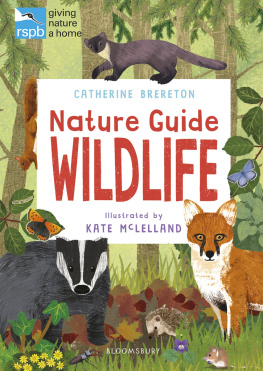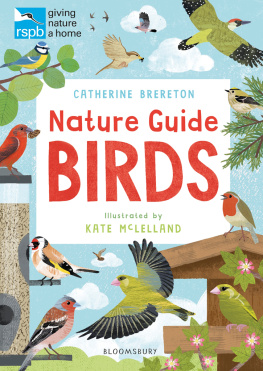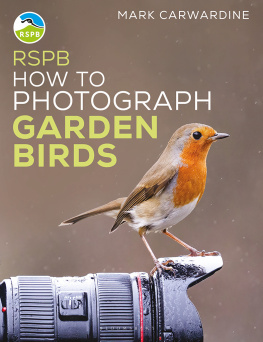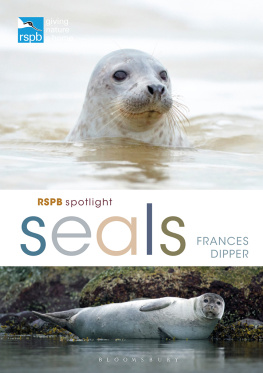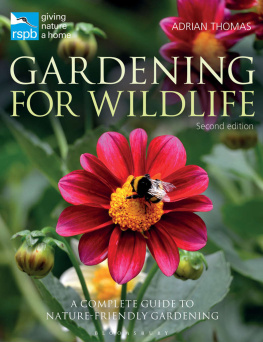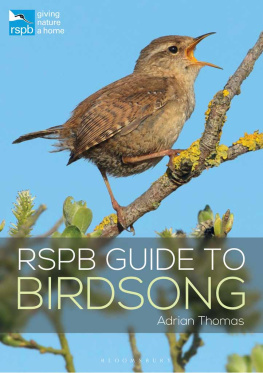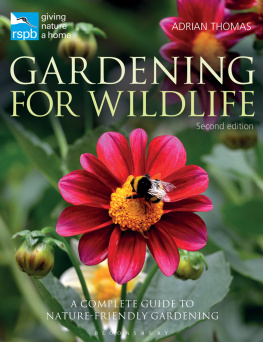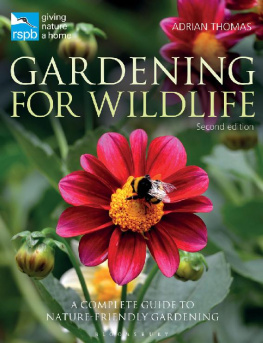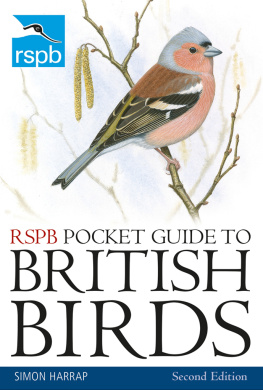Catherine Brereton - RSPB Nature Guide Wildlife
Here you can read online Catherine Brereton - RSPB Nature Guide Wildlife full text of the book (entire story) in english for free. Download pdf and epub, get meaning, cover and reviews about this ebook. year: 2021, publisher: Bloomsbury Publishing, genre: Detective and thriller. Description of the work, (preface) as well as reviews are available. Best literature library LitArk.com created for fans of good reading and offers a wide selection of genres:
Romance novel
Science fiction
Adventure
Detective
Science
History
Home and family
Prose
Art
Politics
Computer
Non-fiction
Religion
Business
Children
Humor
Choose a favorite category and find really read worthwhile books. Enjoy immersion in the world of imagination, feel the emotions of the characters or learn something new for yourself, make an fascinating discovery.
- Book:RSPB Nature Guide Wildlife
- Author:
- Publisher:Bloomsbury Publishing
- Genre:
- Year:2021
- Rating:5 / 5
- Favourites:Add to favourites
- Your mark:
- 100
- 1
- 2
- 3
- 4
- 5
RSPB Nature Guide Wildlife: summary, description and annotation
We offer to read an annotation, description, summary or preface (depends on what the author of the book "RSPB Nature Guide Wildlife" wrote himself). If you haven't found the necessary information about the book — write in the comments, we will try to find it.
RSPB Nature Guide Wildlife — read online for free the complete book (whole text) full work
Below is the text of the book, divided by pages. System saving the place of the last page read, allows you to conveniently read the book "RSPB Nature Guide Wildlife" online for free, without having to search again every time where you left off. Put a bookmark, and you can go to the page where you finished reading at any time.
Font size:
Interval:
Bookmark:

 For Mum and Dad and all the Breretons, and our special wild places: Langley, the Mendips and Ynyslas - C.B. For my little wildlife explorers, Oscar and Elizabeth x - K.M. BLOOMSBURY CHILDRENS BOOKS Bloomsbury Publishing Plc 50 Bedford Square, London, WC1B 3DP, UK This electronic edition published in 2021 by Bloomsbury Publishing Plc BLOOMSBURY, BLOOMSBURY CHILDRENS BOOKS and the Diana logo are trademarks of Bloomsbury Publishing Plc First published in Great Britain 2021 by Bloomsbury Publishing Plc Text copyright Bloomsbury, 2021 Illustrations copyright Kate McLelland, 2021 All rights reserved
For Mum and Dad and all the Breretons, and our special wild places: Langley, the Mendips and Ynyslas - C.B. For my little wildlife explorers, Oscar and Elizabeth x - K.M. BLOOMSBURY CHILDRENS BOOKS Bloomsbury Publishing Plc 50 Bedford Square, London, WC1B 3DP, UK This electronic edition published in 2021 by Bloomsbury Publishing Plc BLOOMSBURY, BLOOMSBURY CHILDRENS BOOKS and the Diana logo are trademarks of Bloomsbury Publishing Plc First published in Great Britain 2021 by Bloomsbury Publishing Plc Text copyright Bloomsbury, 2021 Illustrations copyright Kate McLelland, 2021 All rights reservedYou may not copy, distribute, transmit, reproduce or otherwise make available this publication (or any part of it) in any form, or by any means (including without limitation electronic, digital, optical, mechanical, photocopying, printing, recording or otherwise), without the prior written permission of the publisher. Any person who does any unauthorised act in relation to this publication may be liable to criminal prosecution and civil claims for damages. A catalogue record for this book is available from the British Library ISBN: 978-1-5266-1480-3 (PB)
ISBN: 978-1-5266-2101-6 (eBook) Text by Catherine Brereton To find out more about our authors and their books please visit www.bloomsbury.com where you will find extracts, author interviews and details of forthcoming events, and to be the first to hear about latest releases and special offers, sign up for our newsletters. CONTENTS
 You can get out and about to find it whatever the time of day or year, and wherever you are.
You can get out and about to find it whatever the time of day or year, and wherever you are. You can see wildlife in your garden, street or local park, or you can take a walk in a nearby wood, beside a river or along a beach. You might spend a few minutes watching butterflies and bees busily flying over a patch of wild flowers, or hours patiently waiting to see a badger. This book will help you name many of the wild animals, trees and flowers you see around you, and find out all about them. Theres so much wildlife to discover! What is wildlife?Wildlife is any living thing that is found in the wild. It includes: animals, from large mammals like badgers and foxes to tiny minibeasts such as spiders, worms and ladybirds; plants, from the tallest trees to small flowers and ferns; and fungi, which are not animals or plants. There is wildlife on land, in the sky and in the water.
There are some living things around us that we dont class as wildlife: pets, farm animals, animals in zoos, garden plants - and us!Wildlife and the environmentYou can find wildlife everywhere, but get to know a particular wildlife spot and youll find out that its special. It will have its own characteristics and a unique mix of animals and plants that live and grow there.The different types of wildlife in a place all depend on each other. For example, just one single tree in a woodland may allow hundreds of different insects to survive!Wildlife includes birds, of course! But there are no birds in this book - they have a whole book of their own, RSPB Nature Guide: Birds.Wildlife-watcher rulesWhen youre watching wildlife, remember to respect it. Try to be quiet and still.You might be able to handle some small animals, such as minibeasts, but never harm or frighten animals and dont destroy or pick plants.Have fun watching, listening, taking and drawing pictures or making notes, and join in conservation projects to do things like clearing up beach litter and planting trees. A place where an animal or plant lives is called its habitat. The right habitat will provide the right types of food for an animal to eat and places to shelter and lay eggs or have babies. For a plant, the right habitat will have the right kind of soil, the right amount of light or shade and the right amount of water.
A place where an animal or plant lives is called its habitat. The right habitat will provide the right types of food for an animal to eat and places to shelter and lay eggs or have babies. For a plant, the right habitat will have the right kind of soil, the right amount of light or shade and the right amount of water.
Some animals and plants can live in lots of habitats, but others can only live in particular ones. Gardens and parks Gardens and parks can be good places for wildlife. Trees, bushes and flowers provide food and homes for all sorts of insects and other minibeasts. These are some of the easiest places to spot squirrels, frogs and even hedgehogs.Find out how to encourage wildlife to come to your gardenTowns and cities and homes!
Gardens and parks can be good places for wildlife. Trees, bushes and flowers provide food and homes for all sorts of insects and other minibeasts. These are some of the easiest places to spot squirrels, frogs and even hedgehogs.Find out how to encourage wildlife to come to your gardenTowns and cities and homes! Wildlife can thrive even in the middle of cities - you might see wild flowers, lots of minibeasts and even quite large animals such as foxes. Even in your home you may find spiders, flies, mice and perhaps hibernating butterflies.Woods
Wildlife can thrive even in the middle of cities - you might see wild flowers, lots of minibeasts and even quite large animals such as foxes. Even in your home you may find spiders, flies, mice and perhaps hibernating butterflies.Woods Woodlands are some of the richest wildlife habitats. Just one tree can support thousands of insects and make seeds that are food for small animals.
Woodlands are some of the richest wildlife habitats. Just one tree can support thousands of insects and make seeds that are food for small animals.
Many different flowers and fungi grow in woodlands, too.Fields and hedges Farm fields are often great places for wildlife, especially small mammals such as mice and voles. Around the edges of the fields there may be areas rich in wild flowers, beetles and butterflies. Hedges are especially rich for wildlife - they are like strips of woodland, with a great variety of trees, shrubs and flowers providing food and shelter for animals.Ponds and rivers
Farm fields are often great places for wildlife, especially small mammals such as mice and voles. Around the edges of the fields there may be areas rich in wild flowers, beetles and butterflies. Hedges are especially rich for wildlife - they are like strips of woodland, with a great variety of trees, shrubs and flowers providing food and shelter for animals.Ponds and rivers All living things need water, and where theres a lot of water theres lots of wildlife! Hundreds of different insects and other minibeasts, fish, amphibians and mammals are found in or near rivers and lakes. Some - such as frogs, newts and dragonflies - spend part of their lives in water and part outside of it.The seaside
All living things need water, and where theres a lot of water theres lots of wildlife! Hundreds of different insects and other minibeasts, fish, amphibians and mammals are found in or near rivers and lakes. Some - such as frogs, newts and dragonflies - spend part of their lives in water and part outside of it.The seaside The seaside is a mix of different habitats: cliffs, sand dunes, rocky shores with rock pools, sandy beaches, estuaries (places where the river meets the sea, surrounded by flat stretches of mud) and the sea itself. Each habitat changes twice every day as the tide goes in and out.A rock pool is a great place to get up close to seaside wildlife. You may see fish, crabs, shrimps and anemones, as well as seaweed and lots of barnacles. Wildlife watching never stays the same.
The seaside is a mix of different habitats: cliffs, sand dunes, rocky shores with rock pools, sandy beaches, estuaries (places where the river meets the sea, surrounded by flat stretches of mud) and the sea itself. Each habitat changes twice every day as the tide goes in and out.A rock pool is a great place to get up close to seaside wildlife. You may see fish, crabs, shrimps and anemones, as well as seaweed and lots of barnacles. Wildlife watching never stays the same.
It changes with the seasons - there are different plants and animals to see, and the creatures you see every day are doing different things. Theres always something fun to watch! 
Font size:
Interval:
Bookmark:
Similar books «RSPB Nature Guide Wildlife»
Look at similar books to RSPB Nature Guide Wildlife. We have selected literature similar in name and meaning in the hope of providing readers with more options to find new, interesting, not yet read works.
Discussion, reviews of the book RSPB Nature Guide Wildlife and just readers' own opinions. Leave your comments, write what you think about the work, its meaning or the main characters. Specify what exactly you liked and what you didn't like, and why you think so.

